

The_PLE. Models For Designing Your Personal Learning Environment. A personal learning environment (PLE) is a solution for keeping up with the rapid pace of knowledge change.

Some say it is a concept, while others say it is a technology. I think a good definition is this: a self-directed and evolving environment of tools, services and resources organized by a person seeking a way to accomplish lifetime learning, to create, and to connect with others of similar interests. Because it is personalized, everyone’s PLE will be unique. Because it is collaborative, information may be continually created and shared. In the workplace, designing a personal learning environment has the potential to partially replace conventional courses. Organic Design Versus Planned Design Perhaps your personal learning environment, like mine, emerged organically. The Connected Classroom - SocialNetworking. Social Bookmarking: for sharing resources del.icio.us Personal Networking present information to them in a language they understandfacebook Professional Networking Sites Ning Ning Education GroupsMY NING GROUPS Mr.
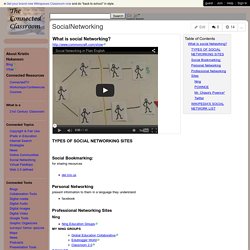
QUEST 2: Personal Learning Environments (PLE) PLN. Learning in a Connected World. I have recently joined the open section of #MSLOC 430 - a graduate course in the Master's Program in Learning and Organizational Change at Northwestern University.
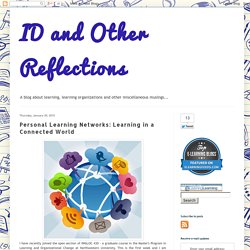
This is the first week and I am absolutely looking forward to exploring the topics, learning from the other participants and participating in exciting conversations. The four topics we are planning to deep dive into in the first two weeks are: a) Networked learning, b) Personal Learning Networks, c) MOOCs, and d) Communities of Inquiry. These are all areas of interest for me, and my hope and plan is to find (make) sufficient time to explore each of these in depth. Given that I have been writing about PLNs and MOOCs for some time now, I thought I would delve a bit deeper into the importance of building PLNs in this post.
These shifts have far-reaching implications on all aspects of our life. MyNotes: Best Practices for Professional Learning Communities. Source: Print Article: Best Practices for Professional Learning Communities MyNotes: One Sentence Summary: The focus of PLCs is ongoing “job-embedded learning,” emphasizing teacher leadership, active involvement and deep commitment to school improvement methods dependent on schools that embrace a culture that supports collaboration, an objective view of their efforts, and share beliefs/behaviors.
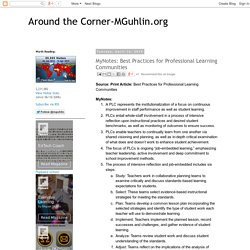
Quotes: The focus of PLCs is ongoing “job-embedded learning,” rather than one-shot professional development sessions facilitated by outsiders, who have little accountability regarding whether staff learning is successfully applied.PLCs emphasize teacher leadership, along with their active involvement and deep commitment to school improvement efforts. Everything posted on Miguel Guhlin's blogs/wikis are his personal opinion and do not necessarily represent the views of his employer(s) or its clients. How to Use Twitter to Grow Your PLN. For many people, Twitter conjures up the worst of the internet: disjointed, meaningless phrases, unrecognizable abbreviations, and endless drivel about where someone's getting their double mocha today.
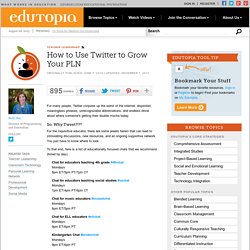
So, Why Tweet?!?! For the inquisitive educator, there are some jewels herein that can lead to stimulating discussions, new resources, and an ongoing supportive network. You just have to know where to look. To that end, here is a list of educationally focused chats that we recommend (listed by day): Chat for educators teaching 4th grade #4thchat Mondays 8pm ET/5pm PT/7pm CT Chat for educators teaching social studies #sschat Mondays 7pm ET/4pm PT/6pm CT Chat for music educators #musedchat Mondays 8pm ET/5pm PT Chat for ELL educators #ellchat Mondays 9pm ET/6pm PT Kindergarten Chat #kinderchat Mondays 9pm ET/6pm PT General education chat #edchat Tuesdays 12 noon ET/ 9am PT 7pm ET/4pm PT.
Daily Genius - The Professional Learning Community. Why I’m Building My PLN (and why you should too!) and Your Friday Finds. I always viewed Twitter as another way to learn pointless information about people.
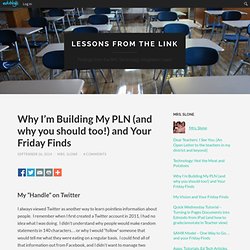
I remember when I first created a Twitter account in 2011, I had no idea what I was doing. I didn’t understand why people would make random statements in 140 characters… or why I would “follow” someone that would tell me what they were eating on a regular basis. I could find all of that information out from Facebook, and I didn’t want to manage two accounts that regularly sucked me into a black hole of wasted time. In fact, this is my first tweet in 2011: It was months before I tweeted again.
It took a little Twitter education for me to see the value of Twitter, and since, it has radically changed the way I view and receive professional development. Are you an avid pinner on Pinterest? Share links and collect opinions. Twitter education chats: An astonishing source of professional development. I have recently discovered Twitter, and it has supercharged my professional development.

The reason? Twitter education chats! Two months ago I would have said, “No, I don’t have a Twitter account.” I may even have been able to vaguely explain why I really don’t have space or reason for Twitter in my life. It certainly did not seem relevant to my work as an educator. How to build a professional learning community (no matter what job you have) - Daily Genius.
Let’s say you have a solid job that lets you have a great work-life balance.
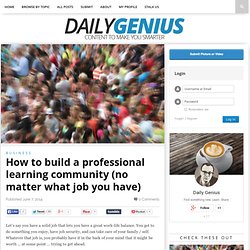
You get to do something you enjoy, have job security, and can take care of your family / self. Whatever that job is, you probably have it in the back of your mind that it might be worth … at some point … trying to get ahead. Maybe you want to learn a new skill and apply for that corner office job? Maybe you want to get better at using social media? Create, Compose, Connect! Reading, Writing, & Learning with Digital Tools To Be Rescheduled Spring 2015 The Fall 2014 series has been cancelled; however, we plan to offer this in Spring 2015.
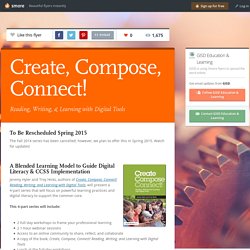
Watch for updates! How to Grow an Engaging Learning Environment. At Holiday Heights Elementary School near Fort Worth, Texas, what was once a patch of Bermuda grass has become a hub for active learning.

Students regularly head to the school garden to learn about plant science, look for migrating Monarch butterflies, write poetry inspired by nature, or check on the potato crop that they will donate to a community food bank. "Many of these children haven't had a lot of experiences in the outdoors," says Scott Smith, a lifelong gardener who doubles as a math and science teacher and garden coordinator at Holiday Heights, a Title I school serving about 700 students from pre-K to fifth grade. "When they go to the garden, they are fully engaged. " That engagement is no accident. The Holiday Heights garden -- complete with tree house, raised beds, and fish pond -- is one of about 100 developed in partnership with REAL School Gardens.
Embracing Connected/Networked Learning - VCU. Personal learning environment. Personal Learning Environments (PLE) are systems that help learners take control of and manage their own learning.[1] This includes providing support for learners to: Set their own learning goals.Manage their learning, both content and process.Communicate with others in the process of learning. A PLE represents the integration of a number of "Web 2.0" technologies like blogs, Wikis, RSS feeds, Twitter, Facebook, etc. around the independent learner.
Using the term "e-learning 2.0", Stephen Downes describes the PLE as: "... one node in a web of content, connected to other nodes and content creation services used by other students. Embracing Connected/Networked Learning - VCU. Video - Community of Practice (CoP) success story. Three Prongs Of Connected Learning. PLE : iTeachU. Information Fluency provides a model for educational activities; the Personal Learning Environment (PLE) is the place where those activities happen. Just as learning activities and their products map to the three areas that comprise Information Fluency, those activities and their products can be mapped to different tools and resources. About the “PLE” How To Create a PLE to Stay Relevant in 2013. “Our understanding of learning has expanded at a rate that has far outpaced our conceptions of teaching.
A growing appreciation for the porous boundaries between the classroom and life experience…has created not only promising changes but also disruptive moments in teaching.” EDUCAUSE Review, 2012. PLEs Focus on the Individual. Infographic: The State of Digital Education. News. "- Can you picture and describe your Personal Learning Environment? - Learning? Isn't that the stuff I had to do at school? - Yes.. but surely you did not stop learning the day you graduated, did you? - True… I suppose my experiences, my goals, my thoughts, my responsibilities, my training, my projects, all constitute ongoing learning..- And it looks you are onto a good thing, so keep with it as "your ability to learn is the only lasting competitive advantage! " History of personal learning environments. Personal learning environments are systems that help learners take control of and manage their own learning. This includes providing support for learners to set their own learning goalsmanage their learning; managing both content and processcommunicate with others in the process of learning.
Intro to communities of practice. The term “community of practice” is of relatively recent coinage, even though the phenomenon it refers to is age-old. How to Infuse Digital Literacy Throughout the Curriculum. So how are we doing on the push to teach “digital literacy” across the K12 school spectrum? From my perspective as a school-based technology coach and history teacher, I’d say not as well as we might wish – in part because our traditional approach to curriculum and instruction wants to sort everything into its place.
Researching the community of inquiry framework: Review, issues, and future directions. Abstract Since its publication in The Internet and Higher Education, Garrison, Anderson, and Archer's [Garrison, D. R., Anderson, T., & Archer, W. (2000). Critical inquiry in a text-based environment: Computer conferencing in higher education.
The Internet and Higher Education, 2(2–3), 87–105.] community of inquiry (CoI) framework has generated substantial interest among online learning researchers. This literature review examines recent research pertaining to the overall framework as well as to specific studies on social, teaching, and cognitive presence. Connected Educator/Learner.
Descriptions. Diagrams. Videos. Development. Definition. PLE - Personal Learning Environment. CoP - Communities of Practice.